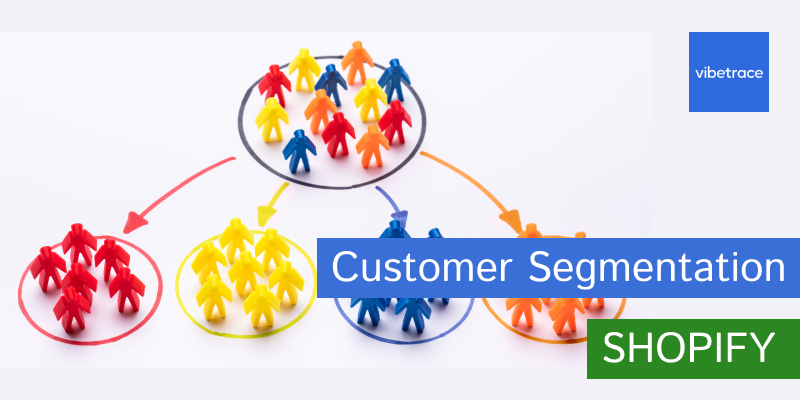If you’re trying to build a successful marketing for your Shopify store, you know that no two customers are the same.
Some are easier to reach, others are more valuable for your business.
Your job as a Shopify store owner or manager is to divide customers in a way that helps the business grow, maximizes ROI, and limits costs.
If you don’t know where to start, start here – with our detailed Shopify customer segmentation guide for marketing.
In today’s article, we’ll discuss how to divide your customer base inside Shopify and use that information for successful marketing.
Let’s get started!
What is Customer Segmentation?
Audience segmentation for marketing in Shopify for marketing requires you to divide people who’ve purchased from you or just visited your website into different groups based on various criteria.
The goal is to gather data on different customer subsets and focus your marketing efforts more efficiently.
To do that, you can take two general approaches:
Based on Shopify User Data
Zero-party and first-party information you gather when people interact with your business allows you to outline various segments.
We’ve discussed those in detail in our customer segmentation article. The most popular segments based on data include:
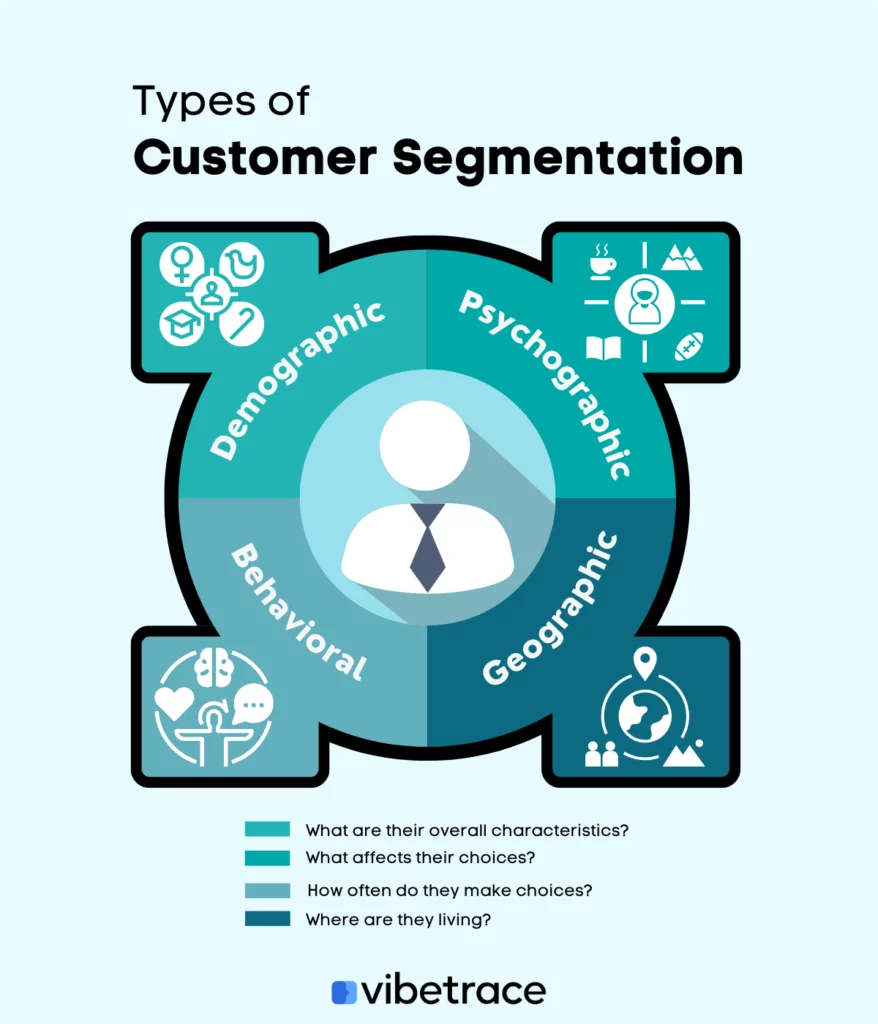
- Demographic Segmentation – based on characteristics such as age, gender, average income, education and degree, career path, and so on.
- Psychographic Segmentation – based on values and desires expressed by specific customers. Psychographic traits are harder to determine and depend on customers’ interests.
- Behavioral Segmentation – based on customers’ interactions with your Shopify store, such as purchase history, browsing patterns, campaign response, etc.
- Geographic Segmentation – based on customers’ location. You can divide them on a deeper level – based on their city and even neighborhood, or do something high-level like state or country if you have international clients.
You can gather a ton of data through customer data platforms like the one featured in the VibeTrace app. When you segment clients, you can focus on the most suitable customers.
And if you’re searching for the most valuable ones, you can choose the second approach or build upon your efforts by further segmenting customers based on their value.
Based on Customer Value (Shopify Purchases)
Carrying out an RFM analysis gives you the best way to divide customers according to how valuable they are to your business. It’s a technical approach that requires time and a clear idea of what matters to your business.
We have a detailed RFM breakdown with various approaches you can use to accomplish it – don’t miss it. Through it, you can derive several customer segments based on value. Apart from the new customers and the ones you’ve lost, you can additionally identify:
- Potentially Loyal Customers – those who purchase from you frequently (compared to most), have higher average monetary value, and their latest purchase occurred recently.
- Loyal Customers & Champions – those who spend the most, most frequently, and have purchased recently, according to your criteria.
- About to Sleep – they purchase infrequently but have made a purchase recently, compared to most.
- At Risk – their spending and frequency have been steadily declining, and they haven’t purchased in a while. If you want to keep them as customers, you must act now.
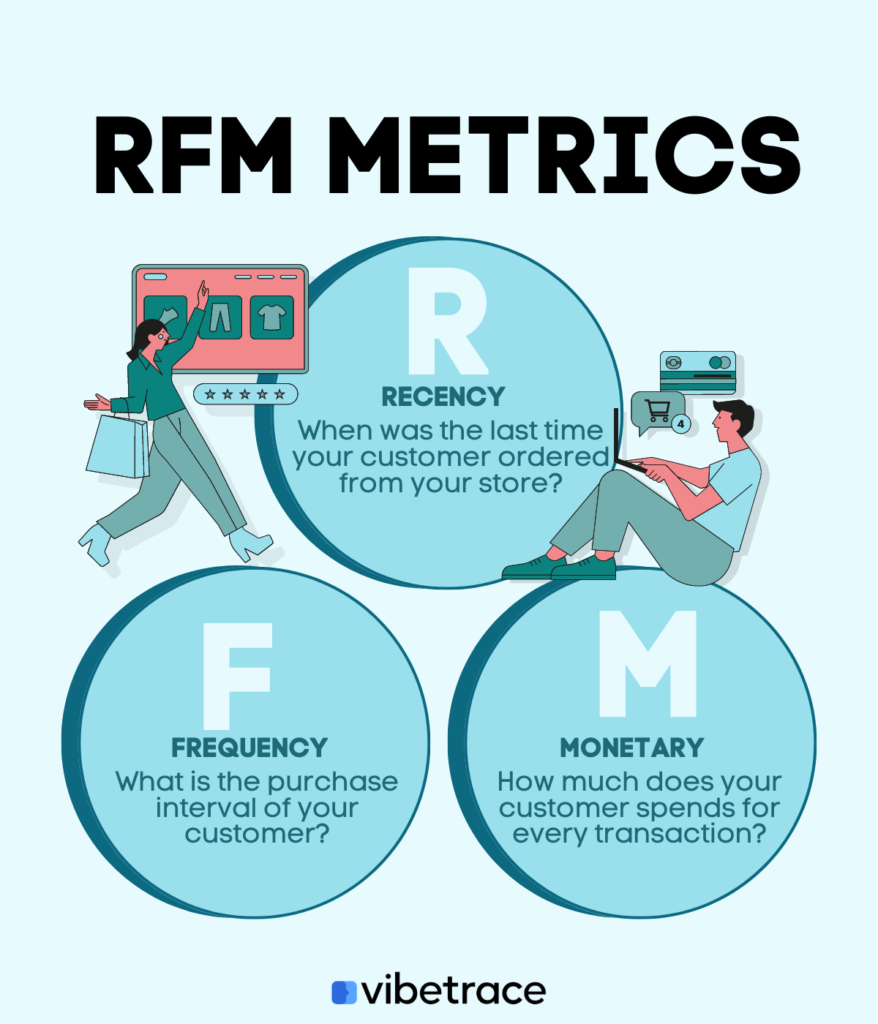
Regardless of which approach you choose (or choose to combine them), you’ll start seeing the benefits the moment you begin focusing specific campaigns on specific segments.
Below, we’ll explore the key benefits of Shopify customer segmentation for marketing – keep reading!
Benefits of Shopify Customer Segmentation for Marketing
As a Shopify store owner or manager, you have access to a treasure trove of data. Don’t let it go to waste. Instead, segment, segment, and segment some more.
From first-time visitors and one-time buyers to loyal customers and champions – that’s possible when making the most out of data. When you rely on audience segmentation for marketing in Shopify, you can tailor content, promotions, and overall communication to specific people.
With that level of personalization and increased relevance, the results are quick to come. The key benefits of such segmentation include:
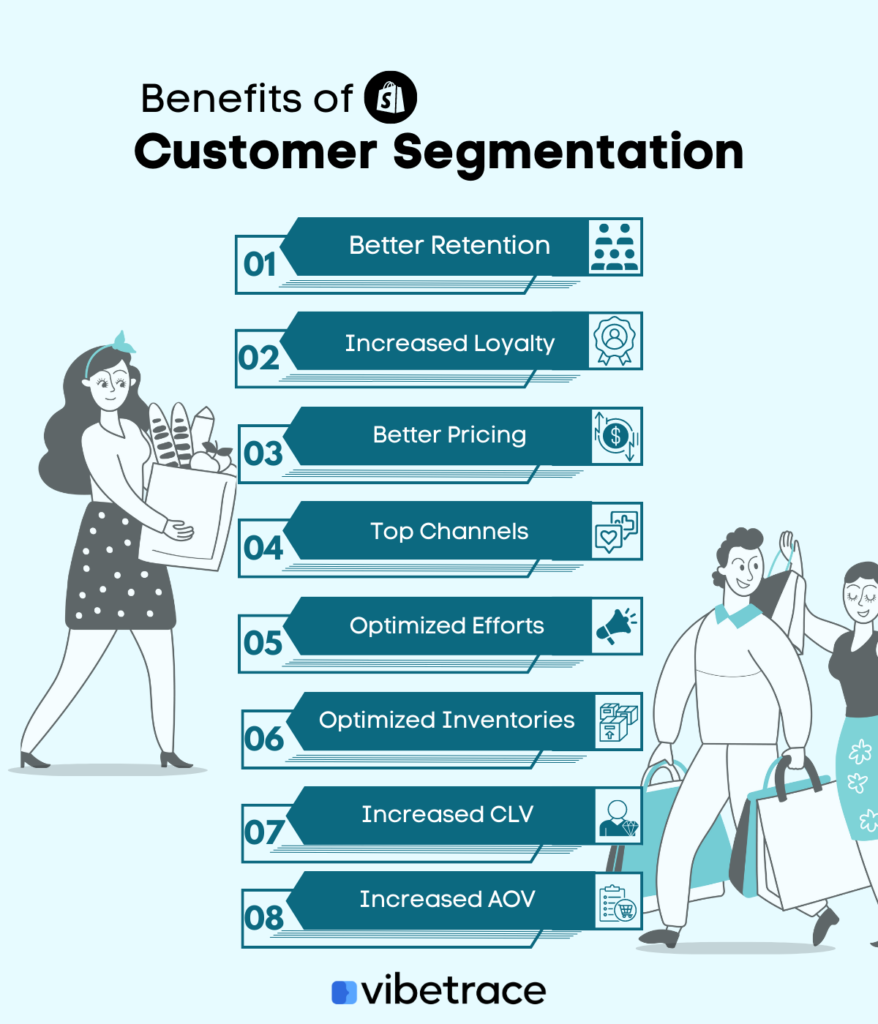
- Better Retention – customer retention plays an essential role in business success since it’s cheaper to keep existing than to gain new customers.
- Increased Loyalty – segmentation helps you stay relevant, and that’s the only requirement customers have. If you’re going to market to them, make it worth their while.
- Better Pricing – optimizing pricing strategies matters if you want to generate results in the first place. Use segmentation to learn more about your customers’ price sensitivity and make the optimal offers at the best prices.
- Top Channels – gathering data and segmenting customers helps you identify your most valuable channels, where customers are most engaged, and how they prefer to be engaged.
- Optimized Efforts – through segmenting Shopify customers, you can identify cold audiences that waste your time and pinpoint the big spenders and most valuable clients to focus your efforts.
- Optimized Inventories – find out what people care about and eliminate the clutter in your store. Segments can point you to the products not worth carrying in your store – something of great value, especially if you’re in the dropshipping niche.
- Increased CLV – by targeting the right customers with the right offers and offering them a quality, tailor-made experience on your store, you can increase the essential customer lifetime value.
- Increased AOV – when you know your Shopify customers better, you can offer them the right products at the right time through upselling, cross-selling, and personalization to increase average order value.
Segmentation plays a pivotal role in successful Shopify businesses. The platform developers understand that, and they’ve given you plenty of instruments to use.
Below, we’ll check out the available Shopify segmentation criteria you can build upon for even better results.
Want to be up to date with Marketing?
Subscribe to our Retail CX newsletter!

Stay connected with what’s really important to optimize your digital revenues.
By clicking the button, you accept our Terms & Conditions. Also you will need to confirm your email address.
Available Criteria for Shopify Customer Segmentation
Shopify tries its best to kick-start your segmentation efforts. The platform comes with several free segmentation criteria based on the data it gathers on your visitors and customers. In the admin panel, you can find filters like:
| FILTER | CRITERION |
| New | Visitors with 0 orders |
| Returning | Customers with at least 2 orders |
| Abandoned Checkouts | Customers that abandoned the checkout process in the past month |
| Email Subscription Status | Customers based on whether they’ve subscribed to receive emails |
| Email Events | Customers based on whether they bounced, clicked, opened, etc. |
| Customer Tags | Customers with specific tags you created |
| Amount Spent | Customers based on how much they’ve spent on your store |
| Number of Orders | Customers based on how many purchases they’ve made |
| Last Order Date | Customers based on a specific purchase date |
| Predicted Spend Tier | Customers based on a forecasted spending potential |
Check out the entire list of filters with their corresponding criteria in the Shopify customer segments documentation.
When using these filters, you can easily create audience subsets, but that’s not the only way to manage your audience inside Shopify. Let’s see what else!
How to Manage Shopify Audience Segments?
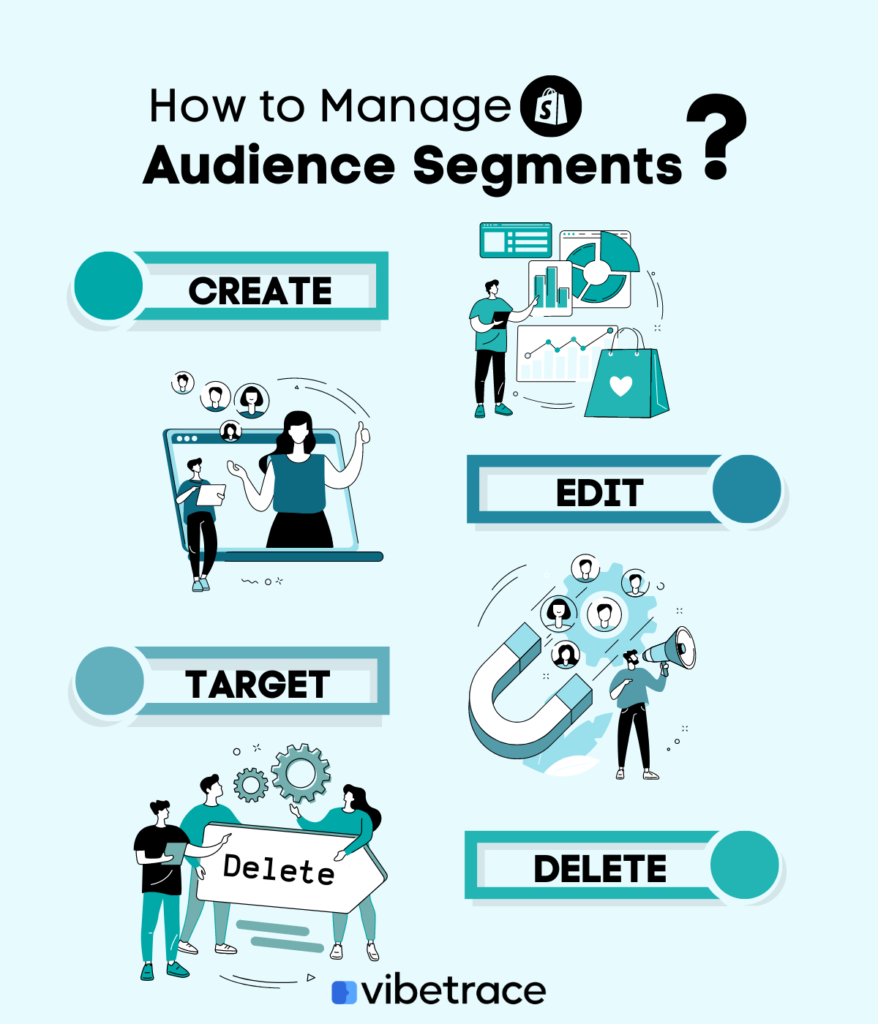
The available Shopify filters feature three elements – a name, an operator (=, <, >, etc.), and a value that characterizes customers. By using the available filters or creating your own, you can:
- Create Segments – by combining various filters with different values and operators. Alternatively, you can use one of the Shopify segment templates as a starting point. The platform also allows you to create subsets of existing segments.
- Edit Segments – you can easily adjust the criteria and filters used to create specific segments. Each subset created in Shopify gives you access to an editor for making the necessary changes and adjustments.
- Target Segments – by combining segmented audiences with email apps like Shopify Email or any other email marketing app you prefer and is available in the app store. You can easily export entire segments right from inside the admin panel.
- Deleting Segments – if you no longer need a specific segment (let’s say you’re no longer shipping ankle boots to customers in Arizona to cut costs, and you don’t want to target them with your offers), you can delete it from inside your Shopify admin panel.
At this point, you’re probably thinking, aren’t these segmenting options too few to be efficient? Indeed, Shopify customer segmentation for marketing based solely on the platforms’ criteria, filters, and capabilities is rather limited.
That’s where Shopify apps for audience segmentation come into play. In the next section, we’ll look at some of the most popular audience segmentation apps you can use to build upon the available capabilities.
Advanced Customer Segmentation For Shopify
Advanced customer segmentation typically includes more detailed demographic, psychographic, and behavioral criteria.
It also typically includes customer lifetime value (CLV), recency, frequency, and monetary value (RFM), as well as purchase patterns, interests, and other more advanced metrics.
So all the above types of segmentation but merged together in order to make sense for you business. For example, an Advanced Customer Segmentation should answer to questions like the following:
- What customer segments do we currently have and what do they look like?
- What are the key characteristics of our most profitable customer segments?
- How do our customer segments differ in terms of their purchasing behavior?
- What types of marketing campaigns are most likely to be effective for each customer segment?
- How can we identify new customer segments that are likely to have high lifetime value?
- How can we use customer segmentation to optimize our pricing and product offers?
- What trends are emerging in our customer segments, and how can we use this information to drive future growth?
Also, initial acquisition source of the customer is very important in order to determine future behaviour. For example you can discover that SEO customers have a 150% higher CLV than the ones acquired through TikTok.
Purchasing Behaviour
There are 6 behavioural segments according to a research from SSRG International Journal
- The individual looking for the best deal is the “Price-conscious” buyer.
- The “Smart” buyer is an individual who does a lot of research before making any decisions.
- The “Risk-averse” buyer is careful and wants assurance that the product is reliable before committing to a purchase.
- The “Needs-proof” buyer requires evidence from other people that a product is reliable.
- The “I’ll get it later” buyer is not in any hurry when it comes to making purchases.
- The “Persuadable” buyer is easily influenced by cross-sell offers.
By looking at customer behavior data from just one channel within a single web session, a lot can be learned about how people make purchasing decisions.
But if data is collected over a longer period of time, across multiple channels, the insight gained could be even more comprehensive.
Customer Journey Stage
There are many articles on the stages of customer journey. Some will tell you there are 4, 5 or even 7. In the end, all of them share similar concepts, but they go into different levels of details.
If we take the highest level one, with only 4 stages, we will have:
- The Awareness stage
- The Consideration stage
- The Decision stage
- Customer Loyalty stage
Or going for the 5 steps in the customer journey, it will have a new stage called Advocacy.
The will reflect the potential of existing customers to bring you more customers from their family or friends. Net Promoter Score is part of this stage.
Customer Loyalty
By looking at customer behavior data, it’s possible to gain an understanding of how loyal customers are. This can be used to pinpoint your most loyal customers and make sure their needs are met.
These customers can also be targeted for special treatment and rewards programs as a way of strengthening the relationship and encouraging more business in the future.
Purchasing Interests
Segmenting customers based on their interests is a great way to personalize their experiences and keep them engaged.
This technique is useful for increasing product usage, providing cross-sell or upsell offers, as well as guiding customers through the process of purchase and advocacy.
You can determine Purchasing Interests using our Product Catalogue segments.
Engagement Level
While segmenting customers by their level of engagement can include website visits, email marketing opens and clicks, it also encompasses a broader spectrum of customer interactions with your brand across all channels where you are present. Both offline and online.
How you define this engagement depends on:
- your company and brand
- industry you are in
- types of products you sell
- number of categories and products you have (a generalist shop might have more engagement)
Usually we can all agree that more engagement is generally better. Better positive experiences with your brand, and therefore more frequent interactions it’s a positive sign for good outcomes.
User Status
Some of the most common examples of user status:
- Non-users
- Prospects
- First-time buyers
- Regular users
- Defectors (ex-customers who found a better alternative)
In order to determine this status, you will need to do a basic segmentation, that can be done directly in Shopify as well.
Apps for Audience Segmentation for Marketing in Shopify
| APP | SEGMENTATION |
| VibeTrace | Uses a powerful Customer Data Platform that collects customer data and helps you outline various custom segments and audiences. It relies on personal, transactional, and events data to provide detailed audience subsets. |
| Klaviyo | Applies predictive analytics and various conditions like list presence, SMS subscriptions, activity and behavior, and custom properties to build detailed segments. |
| Shopify Email | Allows the creation of dedicated email lists based on various criteria like New or Returning customers or based on specific segments you’ve created manually. |
| RetentionX | Helps you outline segments based on RFM, 1st Order Behavior, Overall Purchase Behavior, and Marketing Journey, and allows you to adjust them according to your needs. |
| Segments App | It comes with 30 pre-built segments and helps you identify High spenders, Active repeats, At-risk One-timers, At-risk Repeats, and Churned Loyals. Offers data integrations and custom segments. |

